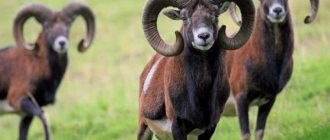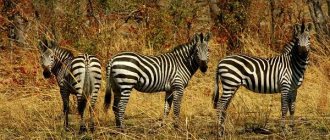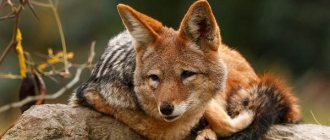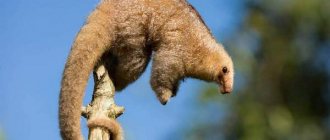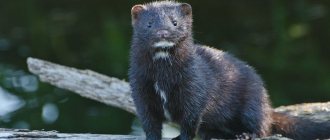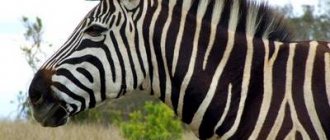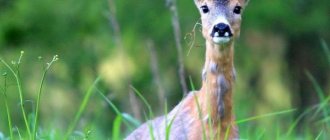- 2.1 Dimensions and weight
- 4.1 Countries of practice
- 5.1 Physique
- 6.1 Dairy breeds
- 8.1 Training and features
Sheep
Domestic sheep are artiodactyl mammals of the sheep genus of the bovid family. Their edible, tasty meat and thick wool in ancient times served as the reason for the domestication of the species by humans.
Why are sheep raised?
— Advertising —
Nowadays, sheep breeding is widely developed to produce sheared sheep wool (fleece) and sheepskin (skin), lamb, sheep milk, feta cheese, and cooking fat. The term “sheep” refers to a female domestic sheep, males are rams, young immature females are bright, and young ones are lambs.
Nutrition
Taste is another well-developed and important sense organ. Sheep eat exclusively sweet and sour herbs, avoiding bitter ones. Vision and touch are involved in choosing herbs to eat.
A sheep is a domestic animal , so in addition to herbs, its diet includes mixtures made by humans. When feeding, the diet is developed based on the purpose of raising the animal.
Thus, mixtures with different ratios of useful elements are usually prepared for feeding meat and wool sheep, estrus and pregnant females, as well as for females during breastfeeding, for rams during a quiet period and when mating is approaching.
Description
The domestic sheep is easily recognized by the male's spirally branched horns and curly coat. Compared to their wild relatives, domestic sheep have narrower eye sockets and smaller brain sizes. Legs are strong, adapted for long journeys.
Dimensions and weight
— Advertising —
The size and weight of domestic sheep varies widely depending on the breed. The average weight of adult females is 45-100 kg, and 70-160 kg for males. The height at the withers is from 55 to 100 cm, the body length is 60-110 cm. The muzzle is pointed at the bottom, with a straight or hook-nosed profile, and pubescent. The lips are thin and mobile. Males have well-developed spirally twisted horns. Females also have small horns. The color of different breeds varies from milky white to dark brown and black.
Care and lifestyle
You can determine which sheep animal is by the waviness and color of the wool. Domestic representatives of the species have long curly hair, wild sheep are animals with straight hair and a short tail. The head of domestic artiodactyls is smaller than that of their wild counterparts, the eyes are smaller and narrower.
The sheep has fine hearing, the viewing angle of the eyes with horizontal pupils is approximately 300 degrees (the sheep can look behind without moving its head). Despite this, sheep love wide, open spaces, avoiding shaded, dark places. In addition to fairly developed vision and hearing, the animal has a whole arsenal of different sounds: roaring, snorting, bleating and grunting.
Listen to the bleating of sheep and lambs
Listen to the voice of the sheep
The most commonly used sound is bleating, which sounds different for each sheep, so animals within the same herd can recognize each other. In addition, loud bleating means an alarm signal - an enemy has appeared not far from the herd, as well as sadness from loneliness (finding themselves isolated from the herd, sheep begin to bleat).
The photo shows a flock of sheep
The remaining sounds have fewer functions - the roar is used by rams during courtship, the snort indicates an aggressive mood of the individual, and the grunt is used by females during childbirth. Sheep usually graze in herds at a short distance from each other, however, this is observed only in open areas; if you drive the herd into a fenced area, the animals will disperse over a considerable distance, as they will feel safe.
To gather a dense herd, a person can use a specially trained dog, which will begin to circle near the sheep - mistaking the dog for a predator, the artiodactyls will press closer to each other, because this is the only opportunity to resist the enemy.
An interesting fact is that sheep grazing in herds regularly break away from eating grass to see if their brothers are still there, this ensures the almost synchronous movement of the animals.
If an inattentive sheep gets separated from the main herd, it will begin to panic and experience severe stress. It has been scientifically proven that in this case, you need to show it your own reflection in the mirror, mistaking yourself for another animal, the sheep will calm down. If the animal somehow manages to roll over onto its back, it will not be able to assume a normal position on its own, i.e., the sheep may die.
Spreading
The first wild sheep were domesticated approximately 6000-7000 years ago in Asia Minor, the Caucasus and Iran. At first they were bred only in mountainous regions, but then it turned out that they easily adapt to a wide variety of conditions, including taking root in arid areas. Sheep gained popularity in the Mediterranean, from where they spread to Western Europe. English colonists brought animals to the USA, South America, Australia and New Zealand.
Countries of practice
Sheep farming is now practiced all over the world. In terms of livestock, China leads (144 million), as well as Australia, India, Iran, New Zealand, Great Britain, South Africa, Turkey, Pakistan, and Spain.
Common sheep breeds
Depending on the purpose of breeding, there are meat, meat and fat, wool, dairy and ornamental sheep. One of the most popular breeds of exceptional meat quality is called the Texel, which is a Dutch breed. Medium or large animals weigh 60-130 kg.
Body type
Their physique is strong, with well-developed muscles, their neck and legs are short. The tail is of medium length. The color is white, cream. The fur is semi-fine, thick and slightly curled. Texel meat does not have an unpleasant odor or taste of fat, and has a marbled structure. The breed is very unpretentious, easily adapts to any conditions, and is resistant to parasites. Turks (Afghanis) are an Afghan breed of fat-tailed sheep. It is distinguished by its large size and weight from 80 to 195 kg. The legs are high, the body is slender, the neck is long, the ears are drooping, the profile is hook-nosed. The coat is short. Color: blue, black, red, fawn. Lamb lard is highly valued in the East and is indispensable for preserving meat in hot conditions.
What do sheep eat?
Sheep are unique animals that can adapt to environmental conditions and are not picky about food.
During the grazing period from spring to autumn they eat: bluegrass, sedge, goose onion, feather grass, fescue, wheatgrass, legumes, knotweed. Foliage of trees and shrubs, various berries can also make up the diet.
With the onset of winter, the branes switch to stable maintenance. There they receive concentrated feed consisting of barley, oats, corn and, of course, hay and 25% straw.
During the table period they can be fed: silage, root vegetables, pumpkin.
Wool sheep include the following breeds:
- The Border Leicester is an English breed, large, with a strong build, slightly squat and elongated, weighing from 60 to 120 kg. The profile is humpbacked, the ears are long. Painting is only white. The length of the coat is 20-25 cm, the curl is wide. Trimmed - 4.5-6 kg.
- Jacob is a medium-sized sheep, weighing 36-82 kg, with an elongated body and a straight back. The breed is distinguished by its multi-horned nature; both males and females have 4 horns. The tail is long. Coloration ranges from cream to brown and black, and piebalds are common. Semi-fine wool of medium quality.
- Karakul - an Uzbek breed, coarse-haired smushka, is the only supplier of astrakhan fur in the world. The sheep is large, weighs 45-90 kg. It has a strong, dry build and floppy ears. Sheared 2.2-3.8 kg of wool per year. The color is black, occasionally gray and white.
- Merino is the most common breed of sheep and is the best supplier of wool. The breed is fine-fleece, the fleece is thick, soft and thin, perfectly absorbs moisture, while maintaining heat-insulating properties. Merino sheep are small in size, wool shearing ranges from 3-5 to 15-18 kg. Painted only white.
Dairy breeds
The dairy breeds include the East Friesian (East Friesian), which was bred in Holland. A large sheep weighing 60-130 kg, strong build, polled. Color white, black, black and white. The tail is long, thin and hairless. The coat is semi-fine, coarsely curled. Annual milk yield is from 300 to 1500 l (2-9 l per day), milk fat content is 2.7-7%.
Decorative breeds
Ornamental sheep are an unofficial group that includes dwarf sheep, as well as the unique Arabian Nejd breed. The latter is a meat and dairy breed bred in Saudi Arabia. The sheep is tall, with high legs, and an average weight of 40 to 85 kg. The neck is long and slender. The ears are long, drooping, and there are no horns. The breed is distinguished by its unusual coat: thin and silky, devoid of undercoat, similar to human hair. The color is spotted, black, white and blue. This is the most expensive breed in the world, the price starts from 5,000-10,000 dollars per animal.
Behavior
Sheep are healthy and hardy animals. They are unpretentious, easy to manage, they are not aggressive, compact, and are not afraid of cold weather. In warm countries, sheep can be kept on pastures all year round; in moderately cold winters, sheds or uninsulated sheds are enough for them. But sheep do not tolerate dampness well, and therefore they are practically not bred in the humid tropics. The disadvantages of sheep are their lack of intelligence, lack of curiosity, and lack of contact. They slowly get used to a new environment and find it difficult to change habits, which leads to animals being considered stubborn. In addition, they have a very strong herd instinct, and sheep can only be kept in large groups. Sheep are sensitive to loud noises and are afraid of the dark and confined spaces. But the listed disadvantages of sheep behavior can also become their advantages. Thus, one shepherd can cope with a herd of thousands of sheep, controlling one leading animal; the herd can even be left without supervision. If you tie one ram, the rest of the herd will remain nearby and will not go anywhere.
Training and features
It is difficult to train sheep, but they can master several commands and remember the shepherds. They are meek, flexible, and have a good disposition. Compared to goats, sheep have a rougher voice and less agility. They do not climb steep slopes and slopes, and do not jump high.
Capital sheepfolds
Winter structures for sheep can be built using different materials - wood, concrete, brick. During the cold season, such sheds maintain an optimal temperature of +6…+12 °C. The walls of sheepfolds are well insulated to avoid drafts.
The floors in such barns are made of wood and raised to a certain height above the ground. The roof of the sheepskin, in order to prevent an increase in humidity, must be waterproofed. Also in sheds of this type, in most cases, exhaust ventilation is installed.
Reproduction
Most sheep breeds are very fertile. They reach sexual maturity at six months, but they reproduce from the age of 1.5 years. Different breeds produce offspring either all year round or seasonally. The duration of pregnancy is 142-155 days. There are usually 1-2 lambs in a litter, sometimes up to 3-5. At the age of 2 weeks they try grass, and at about six months they become independent. Lambs are very active and playful, running around the pastures and constantly jumping up and down. Sheep are used on the farm for up to 6-7 years. The maximum life expectancy is 15-18 years.
Benefits of Breeding
A herd of domestic sheep pays for itself very quickly. Feed costs are minimal, sheep grow very quickly, and young animals can be sent to slaughter as early as 7-8 months. From wool breeds you can get several kilograms of wool. Haircuts are carried out twice a year. A sheep farm can start with a few dozen individuals, and after a couple of years the flock will grow to hundreds or even thousands. As in any agricultural business, sheep farming has its pros and cons, but there are still more positive aspects. There are huge benefits from animals; you can get the following types of products:
- meat;
- sheep fat;
- wool;
- skin;
- milk, butter and cheese;
- manure for fertilizer.
How much does a lamb cost? The price largely depends on the breed and purpose of purchase. A live adult sheep for slaughter can be bought for 110-200 rubles per kilogram of live weight. A small young lamb can cost 2000-4000 rubles. It's no secret that the most expensive breeds are Merinos. Elite fine-wool sheep for breeding are sold for several hundred or even thousands of dollars. It is best to buy sheep from specialized farms at the age of 3-4 months.
Interesting Facts:
- Sheep are used in a variety of ways in the household. They are a source of meat, fat, milk, wool, lanolin, fur and hides. Most breeds are not highly specialized; they are used to produce several products at once, which is very convenient.
- Sheep are even used in scientific experiments. The most famous representative of this species is Dolly the sheep, which became the world's first cloned mammal.
- Sheep milk is popular in Israel, the Caucasus, and the Mediterranean. At first it was valued on a par with meat and bread. But then it gave way to cow’s milk, but the production of sheep cheese based on it remains unique. The most famous among them are feta cheese, Roquefort and feta.
Benefits of keeping sheep in the household
The ram is without a doubt a useful animal on the farm. To maintain and fatten a ram, you do not need a lot of concentrated feed, for example, in comparison, to feed a pig for a season, at least 3 tons per head.
A sheep is given about 0.5 kg of concentrated feed per day, consisting mostly of oats and barley. While wheat is needed to fatten a pig.
Good quality meat is obtained from sheep, very healthy fat is obtained from fat-tailed sheep, and milk is obtained for the production of feta cheese. Carpets are also made from animal wool, and fur coats are made from sheepskin and astrakhan fur.
